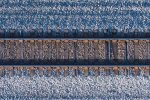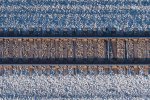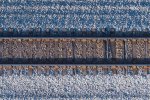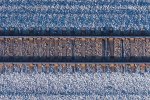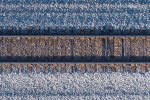I see a lot of posts regarding ND filters for people's drone cameras and each time I ask myself why; why are people buying ND filters for their drone cameras, risking their gimbal motors, potentially damaging their camera lens, etc. etc. for an almost imperceptible amount of additional motion blur if any at all. I have never used an ND filter on any drone that I have owned and I have worked hundreds of projects for paying customers over the years; not a single one has said my footage doesn't have the proper motion blur or asked for a reshoot or a refund because they could tell I didn't have an ND filter on my drone. Sure, if you are shooting the next Hollywood blockbuster and using hexacopters to lift $100K worth of cinema cameras into the air then an ND filter just makes sense.....but for Youtube, Instagram, Vimeo; where your video will probably most commonly be viewed at 320P on a 5" cell phone screen? It makes no sense at all to me.
BACKGROUND
I know a lot of people use ND filters with their drone cameras but in my opinion I think a lot of people use them just because they have read somewhere that they are supposed to use them based on the 180 degree shutter angle rule (i.e. shutter speed "should" be 2x the frame rate). But if you study the reasons why that rule came about you may reach the same conclusion that I did; which is that it doesn't make sense for drone footage.
180 DEGREE SHUTTER ANGLE RULE
The shutter angle/shutter speed rule is meant to reduce or eliminate flicker in certain scenarios such as at night under street lights. Well when you think about it how often is a drone in that situation? The rule is also meant to ensure that there is the "proper" amount of motion blur during fast camera movements; once again, how often is a drone close enough to an object for it to matter? So what about fast moving objects other than the drone.....once again, how often is the drone close enough to that object for the motion blur difference to really be noticeable? And if you still want that barely noticeable motion blur that you feel like you are missing...it takes seconds to add it from within your NLE as you are editing the video.
PROBLEMS WITH DRONE ND FILTERS
So if there's not much benefit to using ND filters on drones are there any downsides? Sure there are:
So after looking at all of the pros and cons I personally just ignore the shutter angle / shutter speed rules and increase my shutter speed as needed to properly expose the scene. With a drone like the EVO II 6K at F11 ISO 100 I can practically point it at the sun and still not be much over 1/200s.
Another thing people then frequently say is..."but they've seen xyz's footage on YouTube and it looks like it is stuttering....if the YouTuber had ND filters and had properly followed the 180 degree shutter angle rule their footage would not have stuttered and been choppy". This is another common misconception; the shutter speed does not make the footage stutter, the typical cause of stuttering YouTube footage is due to whoever shot the footage incorrectly conforming the footage in post to the timeline framerate they intended to render to. Many times people shoot at 60FPS then try to export the timeline to 24FPS.....without properly configuring their NLE to account for the fact that 24FPS is not 50% of 60FPS which brings me to my next point which is that I don't understand why people shoot in 24FPS....but that's another topic/rant for a different day.
WHAT I RECOMMEND
My simple advice to get the best footage out of these drones in bright daylight; shoot at 60FPS or 30FPS, use a 30FPS timeline (29.97FPS), render your footage at 30FPS (29.97FPS), push the F stop to F11 and keep the ISO at 100, then use whatever shutter speed is needed to properly expose the footage and leave the ND filters to the regular cameras or the Hollywood blockbusters. BTW, I have absolutely nothing against ND filters themselves, I use them nearly daily with all of my other cameras to control the shutter speed either for video or for photography; its just that when it comes to drones I can't think of a single use case for the type of projects that I work on where they would provide any value whatsoever.
WHY F11? (New addition -13 Feb 2022)
Every time I mention F11 for my aperture people seem to be shocked...how could I possibly shoot or recommend shooting at F11 when the sharpest aperture for most small drone cameras is around F5.6?
I use F11 specifically because it is slightly less sharp than the sharpest aperture. Drone camera makers grossly oversharpen their video footage in camera which makes the footage look camcorderish to me and causes moire in certain scenes. I shoot at F11 to reduce this affect and to keep the shutter speed around 1/400 or 1/800 on a sunny day. The exception to this is at night; at night I shoot at F2.8 to get maximum exposure and shoot at 1/30s for the same reason.
VALID USE CASES (New Additional - 13 Feb 2022)
This thread has taken some truly fascinating twists and turns as people think for themselves and possibly even perform their own tests and reach their own conclusions. I thought it only fair to update this post with some of the reasons users have given that truly can't be shot any other way than with an ND filter:
This thread (and others related to ND filters on this forum) also uncovered a few complete misconceptions regarding what ND filters can do for their footage:
My only goal with this post was to share my personal experiences using (or should I say not using) ND filters with drone cameras. Obviously, everyone is free to reach their own conclusions and waste their own time and money on ND filters but my goal with this post is to counter the endless YouTube videos and articles that keep the drone ND filter industry in business. I recommend you do your own testing and reach your own conclusions and not just take everyone else's word for it.
And yes, I do use ND filters religiously with my cinema cameras and with photography cameras for things as simple as shutter speed control to shoots where I need to implement a balancing act between HSS, shutter speed, flash recycle times, and AF performance.
IN CASE YOU MISSED IT
Why I Never Shoot Video At 24FPS
Why I Never Use CPL Filters With Drone Cameras
Autel EVO II Pro - User Experience from a DJI User
EXPLORE YOUR WORLD: An Autel EVO II Pro 6K Cinematic Story
Why I ALWAYS use Daylight WB with Drone Cameras
BACKGROUND
I know a lot of people use ND filters with their drone cameras but in my opinion I think a lot of people use them just because they have read somewhere that they are supposed to use them based on the 180 degree shutter angle rule (i.e. shutter speed "should" be 2x the frame rate). But if you study the reasons why that rule came about you may reach the same conclusion that I did; which is that it doesn't make sense for drone footage.
180 DEGREE SHUTTER ANGLE RULE
The shutter angle/shutter speed rule is meant to reduce or eliminate flicker in certain scenarios such as at night under street lights. Well when you think about it how often is a drone in that situation? The rule is also meant to ensure that there is the "proper" amount of motion blur during fast camera movements; once again, how often is a drone close enough to an object for it to matter? So what about fast moving objects other than the drone.....once again, how often is the drone close enough to that object for the motion blur difference to really be noticeable? And if you still want that barely noticeable motion blur that you feel like you are missing...it takes seconds to add it from within your NLE as you are editing the video.
PROBLEMS WITH DRONE ND FILTERS
So if there's not much benefit to using ND filters on drones are there any downsides? Sure there are:
- Another Lens - ND filters are another lens between the camera and the scene which means its another thing that can get smudged, dirty or dusty, and can affect the incoming quality of light. Removing and screwing on that lens could damage the filter threads or you could damage the gimbal trying to get the filter on or off
- Image Degradation - Cheap ND filters can add a color cast, corner softness, chromatic aberration, and other problems to the image the camera records. Even the most expensive ND filters out there tend to add a slightly green cast. Even for my cinema cameras, the stronger ND filters will add a cast that has to be removed in post
- Gimbal Motor Burnout - This was the main reason I chose not to use ND filters years ago. Back then they were heavy and not designed for drones. People were reporting their gimbal motors burning out trying to support the additional weight of the ND filter on the front of the camera. What may feel nearly weightless to humans is still an additional load on the gimbal motor that was not accounted for in the original design of the drone's gimbal motors. These days this is less of an issue, but if the ND filter does not weigh the same or less than the OE filter this is still a possibility
- Cost - ND filter sets for drones are not cheap, they are easy to break and to lose and offer marginal if any benefit to the actual footage. Drones have a very limited lifespan (the avg is 3yrs), so almost every accessory that you buy for one is wasted if you crash it or get a new drone.
- Setup Time - They add to the drone setup time. You have to figure out the proper ND filter based on the current ambient lighting situation and there's always the chance it could change drastically while you are in the air (i.e. the sun goes behind heavy cloud cover or you fly beneath tree cover).
- Camera Modification - If the ND filter has to replace the UV filter you are breaking the original factory sealed filter which will increase the chances of getting dirt, moisture, and other undesirables behind the lens. The better solutions slip over the UV filter....but then there's the weight problem.
So after looking at all of the pros and cons I personally just ignore the shutter angle / shutter speed rules and increase my shutter speed as needed to properly expose the scene. With a drone like the EVO II 6K at F11 ISO 100 I can practically point it at the sun and still not be much over 1/200s.
Another thing people then frequently say is..."but they've seen xyz's footage on YouTube and it looks like it is stuttering....if the YouTuber had ND filters and had properly followed the 180 degree shutter angle rule their footage would not have stuttered and been choppy". This is another common misconception; the shutter speed does not make the footage stutter, the typical cause of stuttering YouTube footage is due to whoever shot the footage incorrectly conforming the footage in post to the timeline framerate they intended to render to. Many times people shoot at 60FPS then try to export the timeline to 24FPS.....without properly configuring their NLE to account for the fact that 24FPS is not 50% of 60FPS which brings me to my next point which is that I don't understand why people shoot in 24FPS....but that's another topic/rant for a different day.
WHAT I RECOMMEND
My simple advice to get the best footage out of these drones in bright daylight; shoot at 60FPS or 30FPS, use a 30FPS timeline (29.97FPS), render your footage at 30FPS (29.97FPS), push the F stop to F11 and keep the ISO at 100, then use whatever shutter speed is needed to properly expose the footage and leave the ND filters to the regular cameras or the Hollywood blockbusters. BTW, I have absolutely nothing against ND filters themselves, I use them nearly daily with all of my other cameras to control the shutter speed either for video or for photography; its just that when it comes to drones I can't think of a single use case for the type of projects that I work on where they would provide any value whatsoever.
WHY F11? (New addition -13 Feb 2022)
Every time I mention F11 for my aperture people seem to be shocked...how could I possibly shoot or recommend shooting at F11 when the sharpest aperture for most small drone cameras is around F5.6?
I use F11 specifically because it is slightly less sharp than the sharpest aperture. Drone camera makers grossly oversharpen their video footage in camera which makes the footage look camcorderish to me and causes moire in certain scenes. I shoot at F11 to reduce this affect and to keep the shutter speed around 1/400 or 1/800 on a sunny day. The exception to this is at night; at night I shoot at F2.8 to get maximum exposure and shoot at 1/30s for the same reason.
VALID USE CASES (New Additional - 13 Feb 2022)
This thread has taken some truly fascinating twists and turns as people think for themselves and possibly even perform their own tests and reach their own conclusions. I thought it only fair to update this post with some of the reasons users have given that truly can't be shot any other way than with an ND filter:
- Customer Mandated Shutter Speed - One user here posted that his customer mandated a specific shutter speed for the footage. I have never heard of this or had this type of customer; but if you happen to have a customer who is so micromanaging your project that they even specify the shutter speed then an ND filter may be the only way to achieve proper exposure. Personally, I'd probably not even work with such a customer because to me that's like a customer telling the chef what ingredients to use in their recipe. They hired me to do the job so let me use my experience to achieve the best results for their project.
- Long Exposure - A few users have reported that they use long exposures with their drones for things like waterfalls and car taillight contrails. Personally, I do not do this and in my opinion drone platforms are not stable enough to produce commercially viable results when the shutter speed drops that low due to micro-vibrations and movement, but I agree, if you just want to post to social media and need a long exposure then during the day an ND filter is the only way to achieve it.
- Maximum Shutter Speed Limitations - Some cameras have low maximum shutter speeds such as 1/2000 or 1/4000. There could be some scenarios where the image is still overexposed even when using the maximum shutter speed especially if the aperture is fixed. In this scenario the only option would be to use an ND filter to properly expose the image.
This thread (and others related to ND filters on this forum) also uncovered a few complete misconceptions regarding what ND filters can do for their footage:
- Reduce Glare - ND filters will in no way whatsoever reduce glare. All an ND filter does is allows you to use a slower shutter speed to achieve proper exposure, this in no way affects the glare.
- Increase Dynamic Range - DR is a fixed value based on the sensor and to a lesser extent the LOG curve used, ND filters will in no way increase it.
- Increase Contrast - ND filters can in no way increase contrast. Some cheaper ND filters introduce a cast which can look like increased contrast, but that's a byproduct of cheap filters and is undesirable.
- Improve Colors - A true high quality ND filter can in no way improve colors of an image. Similar to increasing contrast however, cheap ND filters can leave a green cast on the footage which some users may actually perceive as an improvement but in reality it is an undesirable side effect.
- Fix Prop Shadows / Flickering - These occur when the sun passes through the blades of the drone before hitting the camera lens. The result is a very annoying flickering/shadow effect. An ND filter could be used to lower the shutter speed to attempt to eliminate this, but its marginally successful at best; all you need is to change the camera's angle in relation to the sun to fix this issue; either by tilting the camera further down or rotate the drone. Some users have also created their own lens hoods to fix this problem.
My only goal with this post was to share my personal experiences using (or should I say not using) ND filters with drone cameras. Obviously, everyone is free to reach their own conclusions and waste their own time and money on ND filters but my goal with this post is to counter the endless YouTube videos and articles that keep the drone ND filter industry in business. I recommend you do your own testing and reach your own conclusions and not just take everyone else's word for it.
And yes, I do use ND filters religiously with my cinema cameras and with photography cameras for things as simple as shutter speed control to shoots where I need to implement a balancing act between HSS, shutter speed, flash recycle times, and AF performance.
IN CASE YOU MISSED IT
Why I Never Shoot Video At 24FPS
Why I Never Use CPL Filters With Drone Cameras
Autel EVO II Pro - User Experience from a DJI User
EXPLORE YOUR WORLD: An Autel EVO II Pro 6K Cinematic Story
Why I ALWAYS use Daylight WB with Drone Cameras
Last edited:


